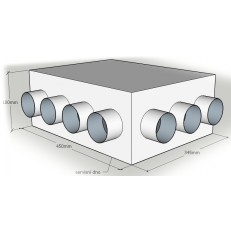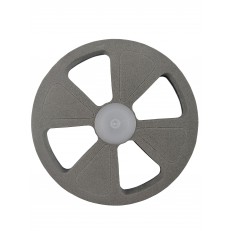Preheating for recovery
AIRMEN ADVISE …
HOW TO CHOOSE A RECOVERY UNIT - PREHEATING YES OR NO, WHAT IS ANTI-FREEZE PROTECTION
What happens in the winter in the recovery unit
The so-called preheating serves to preheat the outside air that enters the recuperator. The problem mainly concerns diagonal countercurrent heat exchangers, which have high efficiency. As described in the previous article, the recuperator consists of fine, shaped lamellas through which cool outdoor air flows in one direction and warm, sometimes very humid, air from the interior flows in the other. In the normal case, the exhaust air will heat up the entire recuperator. It thus transfers heat along the entire length of the exchanger. In winter, water vapor condenses on the walls of the recuperator, which further increases the efficiency of recuperation. However, if the outside temperature is e.g. below -5 °C for a long time and the inside 20 °C, then it may happen that the exhaust air does not have sufficient capacity to heat the recuperator along its entire length. This creates a risk that the resulting condensate may begin to freeze, increase its volume and irreversibly destroy the delicate lamellae of the recuperator within a short time.
Antifreeze protection of recovery units
Due to the possibility of recuperator freezing, almost all units are equipped with so-called anti-freeze protection. It monitors the temperatures at the exhaust from the unit and in the event of a drop below a given temperature, e.g. 2 °C, it triggers a certain type of protection. Each manufacturer solves this problem in its own way.
A) The basic solution to antifreeze protection is to turn off the unit (e.g. EHR 140 Akor ).
B) Some units turn off the suction into the house for a certain time, so that the exhaust air quickly warms up the recuperator. Then it switches back to normal mode. The representative is units from the 2VV company.
C) A more sophisticated procedure is to simply lower the inlet to the outlet. At certain intervals, the unit measures the temperature and accordingly either reduces the supply by another 25%, or on the contrary increases it and the unit returns to normal.
D) An interesting way is to use mixing. EHR 280 AKOR or EHR 325 AKOR units are known for this solution. If necessary, it does not suck in 100% of the air from outside, but part of the incoming air is sucked in through the so-called fifth throat of the unit. The problem may arise if the unit is not placed in a completely clean space or a space where negative pressure must not occur (fireplace, gas appliances, etc.). This creates a negative pressure in the entire house.
This solution can be used with MSK-AFP on all units without preheating.
E) The last 100% effective solution is integrated air preheating in the unit or preheating on the suction pipe (ground, water, electricity, …)
How preheating works and what are the types of preheating
By using any functional type of preheating, it is ensured that the unit does not fall into the so-called frost protection mode. This means that it always supplies and removes the amount of air that you need.
1) Ground exchanger
it is 100% effective when done correctly. However, there is the suitability of the subsoil, the size of the plot, the initial investment, the increased power of the fans (which must overcome the higher pressure loss), the aspect of hygiene and the necessary service. However, a big advantage is the possibility of "pre-cooling" the intake air in the summer.
2) Water exchanger
is usually placed on the intake manifold. The problem is its possible freezing and related measures. So we are getting into a situation where we are dealing with two anti-freeze protections at once. This can of course be circumvented by using a medium with a lower triple point temperature. The advantage is economically lower consumption (we use the main heating source for a family house, e.g. gas or heat pump).
3) Electric heater - INTEGRATED in unit or DUCT
They are the most common types of preheating of recuperation units at all. The advantage of integrated preheating is problem-free assembly without any restrictions. The only disadvantage is the increase in the price of the unit. With pipe heaters, it is necessary to observe fire safety measures, such as: - in front of and behind the heater it is necessary to install at least 0.5 m of steel pipe to avoid contact with flammable parts - use of an air flow sensor or a pressure sensor to block the operation of the heater in the event of a drop flow, or flow rates below the permitted limit.
You must have thought, what is the point of saving energy by recuperation and then heating the air with an electric heater with a power of 1.4 kW?
This is of course a good question, so it is good to choose an adequate heater and in case of very low temperatures reduce the power of the unit. The heaters are manufactured in such a way that they only preheat the air as much as is needed, so they are continuously regulated (0-100%), so if the temperature outside is close to 0 °C, then the consumption is really minimal. Electric heaters are usually equipped with heating coils or so-called PTC elements, which, in our experience, are somewhat more economical.
In general, we recommend that you study the instructions for your chosen unit in detail and familiarize yourself with the logic of the unit's anti-freeze protection. If the information is not available, please inform us and we will try to find it directly with the manufacturer.
If you need a personal consultation, call or write!
Pipeline electric preheaters: HERE
Units with integrated preheating: VENUS , SAVE
Units with mixing flap: EHR 280 AKOR and EHR 325 AKOR














